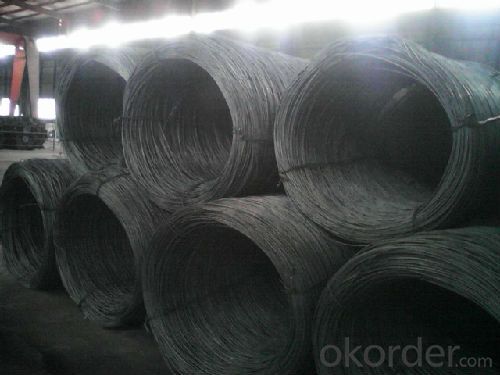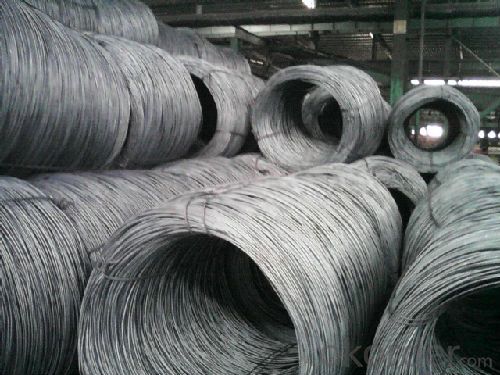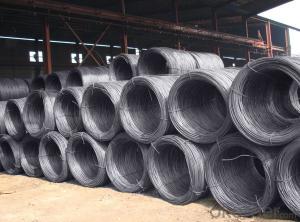Steel Wire Rod Hot Rolled SAE1008B in China
- Loading Port:
- Tianjin
- Payment Terms:
- TT or LC
- Min Order Qty:
- 27 m.t.
- Supply Capability:
- 20000 m.t./month
OKorder Service Pledge
OKorder Financial Service
You Might Also Like
Product Description:
OKorder is offering Steel Wire Rod Hot Rolled SAE1008B in China at great prices with worldwide shipping. Our supplier is a world-class manufacturer of steel, with our products utilized the world over. OKorder annually supplies products to European, North American and Asian markets. We provide quotations within 24 hours of receiving an inquiry and guarantee competitive prices.
Product Applications:
Steel Wire Rod Hot Rolled SAE1008B in China are ideal for structural applications and are widely used in the construction of buildings and bridges, and the manufacturing, petrochemical, and transportation industries.
Product Advantages:
OKorder's Steel Wire Rod Hot Rolled SAE1008B in China are durable, strong, and resist corrosion.
Main Product Features:
· Premium quality
· Prompt delivery & seaworthy packing (30 days after receiving deposit)
· Corrosion resistance
· Can be recycled and reused
· Mill test certification
· Professional Service
· Competitive pricing
Product Specifications:
1.commodity:steel wire rod
2.grade:Q195,SAE1008B-SAE1018B
3.diameter:5.5mm-14mm
4.type:in coil
5.coil weight:around 2 mt
Specification | Diameter: 5.5mm-14mm Weight of coils:50kgs or as your requirement |
Certificate | ISO9001-2008 |
Type | Low Carbon; Middle Carbon; High Carbon |
Material | Q195,Q215,Q235B,E235B,C45,C50,C55,C60,C65,C70,C75,65Mn,C72A,C72B,C80,C82B,SAE65,SAE70,SAE1006,SAE1008,SAE1010,SAE1015,SAE1018,65Mn,CT9A,GCr15, AND SO ON |
Kinds of Product | Spring Steel Wire; Cold -drawn Non-alloy Steel Wire For Springs;Carbon Steel Wires;Umbrellastand Wire; Steel Wires for Spoke; Mild Steel Wire for Important Purposes; Low Carbon Steel Wire for General Uses; Carbon Constructional Quality Steel Wires; Wire for Steel Wire Ropes Use; Galvanized Steel Wire rope; Copper Coated Steel Wire Rope etc. |
Tolerance | 1:Diameter: ±0.001 |
Tensile strength | 1400--3520 b/MPa |
Usage | Use for making Bed spring wire, Spring steel wire, Rope making wire, Tire wire, Spoke wire, High carbon steel wire, Low carbon steel wire, Cold drawn steel wire, Heat drawn steel wire, Free cutting wire, Border wire (may straightening and straight ruler) |
Packing | packing coil, plastic spool, reel bag, drum, carton and so on or according to the customer request |
trade term | FOB; CNF; CIF PORT: Xingang, Tianjin, China |
payment | T/T ,IRREVOCABLE L/C AT SIGHT |
delivery time | 1 week (1 container)after receipt of the T/T or L/C, depend on quantity |
Grade | Chemical composition table (%) | |||||
C | Mn | Si | S | P | B | |
SAE1008B | ≤0.10 | 0.3~0.50 | ≤0.15 | ≤0.050 | ≤0.040 | ≥0.0008 |
mechanical properties | ||||||
YAI (N/mm2) | Tensile Strength (N/mm2) | Elongation (%) | ||||
≥195 | 315-430 | ≥30 | ||||
FAQ:
Q1: Why buy Materials & Equipment from OKorder.com?
A1: All products offered byOKorder.com are carefully selected from China's most reliable manufacturing enterprises. Through its ISO certifications, OKorder.com adheres to the highest standards and a commitment to supply chain safety and customer satisfaction.
Q2: How do we guarantee the quality of our products?
A2: We have established an advanced quality management system which conducts strict quality tests at every step, from raw materials to the final product. At the same time, we provide extensive follow-up service assurances as required.
Q3: How soon can we receive the product after purchase?
A3: Within three days of placing an order, we will begin production. The specific shipping date is dependent upon international and government factors, but is typically 7 to 10 workdays.
Q4: What makes stainless steel stainless?
A4: Stainless steel must contain at least 10.5 % chromium. It is this element that reacts with the oxygen in the air to form a complex chrome-oxide surface layer that is invisible but strong enough to prevent further oxygen from "staining" (rusting) the surface. Higher levels of chromium and the addition of other alloying elements such as nickel and molybdenum enhance this surface layer and improve the corrosion resistance of the stainless material.
Q5: Can stainless steel rust?
A5: Stainless does not "rust" as you think of regular steel rusting with a red oxide on the surface that flakes off. If you see red rust it is probably due to some iron particles that have contaminated the surface of the stainless steel and it is these iron particles that are rusting. Look at the source of the rusting and see if you can remove it from the surface.
Images:



- Q:What are the different types of steel wire rod surface cleaning chemicals?
- There are several types of steel wire rod surface cleaning chemicals available, including acid-based cleaners, alkaline cleaners, solvent-based cleaners, and detergent-based cleaners. Each type of chemical is designed to remove different types of contaminants and provide specific cleaning benefits.
- Q:How is steel wire rod processed into different shapes and sizes?
- Steel wire rod is processed into different shapes and sizes through a series of manufacturing processes. Initially, the wire rod is cleaned and descaled to remove any impurities. It is then heated and passed through a series of rolling mills, which gradually reduce its diameter while increasing its length. The wire is then cooled and coiled onto spools or cut into desired lengths. Further shaping and sizing can be achieved through processes like drawing, annealing, and coating, depending on the intended application of the wire.
- Q:What are the common applications of alloy and oil tempered steel wire rod?
- Alloy and oil tempered steel wire rods are commonly used in various industries and applications. These include automotive manufacturing, construction, aerospace, electrical, and general engineering. Alloy steel wire rods are utilized in the production of high-strength components such as springs, fasteners, gears, and shafts. Oil tempered steel wire rods, on the other hand, are specifically designed for applications requiring excellent durability and resistance to wear, making them suitable for manufacturing high-quality springs, suspension systems, and tools.
- Q:What are the main factors affecting the market partnerships of steel wire rod?
- The main factors affecting the market partnerships of steel wire rod include the demand and supply dynamics of the steel industry, price fluctuations, competition among suppliers, technological advancements, regulatory policies, and the economic stability of the countries involved. Additionally, factors such as quality standards, customer preferences, and the ability to meet specific requirements also play a significant role in shaping market partnerships in the steel wire rod industry.
- Q:How is steel wire rod used in the manufacturing of window and door frames?
- Steel wire rod is used in the manufacturing of window and door frames to provide strength, durability, and stability to the frames. It is commonly used to reinforce the corners and joints of the frames, ensuring they can withstand the weight and pressure placed on them. Additionally, steel wire rod is often used as a support structure within the frames, helping to maintain their shape and prevent warping or bending over time.
- Q:How is steel wire rod used in the production of wire mesh for animal enclosures?
- Steel wire rod is an essential element in manufacturing wire mesh for animal enclosures, as it serves as the primary material from which the wire mesh is formed. The wire rod, typically composed of low carbon steel, undergoes a series of processes to achieve the desired wire mesh. To begin, the steel wire rod is drawn through a set of dies to reduce its diameter and increase its length. This wire drawing process ensures that the wire rod possesses the appropriate thickness and strength required for its intended use in animal enclosures. Once the wire has been drawn, it is often galvanized to enhance its durability and resistance to corrosion. Galvanization entails immersing the wire in molten zinc, resulting in a protective zinc coating that effectively prevents rust and prolongs the lifespan of the wire mesh. Subsequently, the galvanized wire is either woven or welded together to form the wire mesh structure. Woven wire mesh is created by interlocking the wires in a crisscross pattern, resulting in a robust and flexible mesh. Conversely, welded wire mesh is fashioned by joining the wires together at their intersections, yielding a more rigid and stable mesh. The wire mesh produced from steel wire rod offers several benefits for animal enclosures. Its strength and durability enable it to withstand the impact and pressure exerted by animals, ensuring their safe containment. Additionally, the small gaps between the wires provide ventilation and visibility, allowing animals to see their surroundings while maintaining a secure enclosure. In conclusion, steel wire rod plays a crucial role in the production of wire mesh for animal enclosures, providing the necessary strength, durability, and security to create a safe and reliable enclosure for various types of animals.
- Q:How is the elongation of steel wire rod determined?
- The elongation of a steel wire rod is determined by measuring the change in length of the wire when subjected to a tensile force. This can be achieved by clamping the wire at both ends, applying a known force, and then measuring the increase in length using a device called an extensometer. The elongation is calculated by dividing the change in length by the original length of the wire and multiplying it by 100 to express it as a percentage.
- Q:How is steel wire rod used in the manufacturing of wire mesh trays?
- Steel wire rod is used in the manufacturing of wire mesh trays as it serves as the primary raw material. The wire rod is first drawn through a series of dies to reduce its diameter and increase its length, resulting in a thinner and longer wire. This wire is then woven or welded to form a mesh pattern, creating the structure of the wire mesh tray. The strength and durability of steel wire rod make it an ideal choice for wire mesh trays, providing support and stability for various applications such as organizing cables, supporting electrical components, or storing items in industrial settings.
- Q:What are the different types of steel wire rod annealing furnaces?
- There are several types of steel wire rod annealing furnaces, including bell-type furnaces, walking beam furnaces, and roller hearth furnaces. Each type has its own unique design and operation, but they all serve the purpose of heating the steel wire rods to a specific temperature and then slowly cooling them to improve their mechanical properties and eliminate internal stresses.
- Q:What are the factors that affect the tensile strength of steel wire rod?
- There are several factors that can affect the tensile strength of steel wire rod. These include: 1. Chemical composition: The specific combination of elements in the steel, such as carbon, manganese, and silicon, can significantly impact its tensile strength. Higher carbon content generally leads to greater strength, while other alloying elements can further enhance or reduce strength depending on their properties. 2. Heat treatment: The process of heating and cooling steel wire rod can alter its microstructure and ultimately affect its tensile strength. Various heat treatment methods, such as quenching and tempering, can be employed to achieve the desired strength level. 3. Manufacturing process: The way the steel wire rod is produced and processed can also influence its tensile strength. Factors such as rolling temperature, reduction ratio, and cooling rate can affect the alignment of the steel's crystalline structure, which in turn affects its strength properties. 4. Grain size: The size of the grains in the steel wire rod can have an impact on its tensile strength. Smaller grain sizes generally lead to higher strength, as they provide more barriers for dislocations to move through the material. 5. Surface condition: The presence of surface defects, such as cracks or scratches, can act as stress concentrators and weaken the tensile strength of the steel wire rod. Therefore, proper surface treatment and handling during manufacturing and transportation are crucial in maintaining its strength. 6. Environmental conditions: The environment in which the steel wire rod is used can also affect its tensile strength. Factors such as temperature, humidity, and exposure to corrosive substances can lead to degradation or embrittlement of the material, resulting in reduced strength. Overall, the tensile strength of steel wire rod is influenced by a combination of its chemical composition, heat treatment, manufacturing process, grain size, surface condition, and environmental factors. Understanding and controlling these factors are essential in ensuring the desired strength and performance of the steel wire rod in various applications.
1. Manufacturer Overview |
|
|---|---|
| Location | |
| Year Established | |
| Annual Output Value | |
| Main Markets | |
| Company Certifications | |
2. Manufacturer Certificates |
|
|---|---|
| a) Certification Name | |
| Range | |
| Reference | |
| Validity Period | |
3. Manufacturer Capability |
|
|---|---|
| a)Trade Capacity | |
| Nearest Port | |
| Export Percentage | |
| No.of Employees in Trade Department | |
| Language Spoken: | |
| b)Factory Information | |
| Factory Size: | |
| No. of Production Lines | |
| Contract Manufacturing | |
| Product Price Range | |
Send your message to us
Steel Wire Rod Hot Rolled SAE1008B in China
- Loading Port:
- Tianjin
- Payment Terms:
- TT or LC
- Min Order Qty:
- 27 m.t.
- Supply Capability:
- 20000 m.t./month
OKorder Service Pledge
OKorder Financial Service
Similar products
New products
Hot products
Related keywords




























